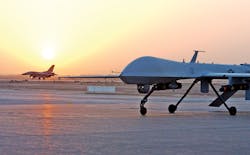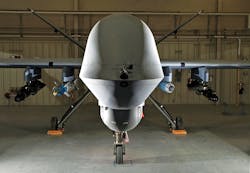Download this article as a .PDF
Surveillance has long been one of several ways of keeping track of an adversary. Once referred to simply as “spying” on an enemy, surveillance has grown in sophistication, enabled very much by advances in analog, digital, and mixed-signal electronics. Put simply, as electronic devices increase in performance and capability within smaller-sized packages, long-distance surveillance capabilities increase in direct proportion.
Electronic surveillance devices, which are largely linked to remote-controlled, robotic vehicles, have become the long-distance eyes and ears of the military, with the U.S. Air Force coordinating most surveillance efforts as part of its Distributed Common Ground System (DCGS), also known as the AN/GSQ-272-SENTINEL system. It is the Air Force’s main intelligence, surveillance, and reconnaissance (ISR) system for the purpose of critical data collection, processing, exploitation, analysis, and dissemination (CPAD) of intelligence data throughout the branches of the armed forces and allies.
Unmanned aerial vehicles (UAVs) are a large part of the Navy’s DCGS, using advanced cameras and sensor arrays and secure communications systems to collect and disseminate ISR data. Nonetheless, other branches of the military have made significant investments in UAVs for ISR and tactical applications. The U.S. Army’s Unmanned Aircraft Systems (UAS) program is a roadmap for UAV development for the next several decades, building upon the baseline success of the Pioneer UAV and its many successful combat missions in the early 1990s in Iraq and Afghanistan. The Army, Navy, and Air Force are guided by reduced size, weight, and power (SWaP) goals when developing future UAVs for surveillance or tactical use.
Tactical UAVs, whether for ISR or offensive missions, are classified by size and weight, which also tend to translate into range and endurance, or the total time a UAV can remain in flight per mission. They are categorized by tiers, with Tier III being the largest and highest-altitude UAVs and Tier I being the smallest and lowest in altitude.
Among the largest UAVs in use for tactical and ISR applications is the Global Hawk (Fig. 1) from Northrop Grumman. Considered a high-altitude, long-endurance (HALE) UAV, it is designed to provide near real-time ISR over large geographic areas. The electronics on board the Global Hawk are designed to match its impressive flight capabilities, with run times exceeding 32 hours. It is designed to carry an Enhanced Integrated Sensor Suite (EISS) payload, as well as an Airborne Signals Intelligence Payload (ASIP) for long-range detection and intelligence gathering.
1. The Global Hawk is a Tier III UAV with long-endurance, long-distance surveillance capabilities. (Photo courtesy of Northrop Grumman)
The Global Hawk’s EISS contains a synthetic-aperture-radar (SAR) system, a moving target indicator (MTI), an electro-optical (EO) digital camera, and an advanced infrared (IR) sensor. All of these detection systems operate using a common signal processor, with the on-board computer enabling simultaneous operation of the SAR and MTI, coupled with the capability of transferring ISR data to warfighters in real time.
As a large Tier III UAV, the Global Hawk has impressive physical features, with a wingspan of 130.9 ft. (39.9 m), a length of 47.6 ft. (14.5 m), and a height of 15.4 ft. (4.7 m). It is designed to reach a maximum altitude of 60,000 ft. with a payload of 3,000 lb. It is capable of endurance as long as 32 hours for long-range missions and can be equipped for flexible ISR duties, as well as for full-scale combat missions. Northrop Grumman recently upgraded the Global Hawk by developing and integrating the MS-177 sensor payload for the UAV (Fig. 2). The new sensor payload incorporates different sensor technologies for enhanced detection and tracking of targets even through crowded environments.
2. The sensor suite on the Global Hawk was recently enhanced with the integration of the multiple-sensor MS-177 sensor payload. (Photo courtesy of Northrop Grumman)
In comparison, the smaller Tier II MQ-1 Predator (Fig. 3) from General Atomics Aeronautical Systems is about one-half the size of the Global Hawk. It has a wingspan of 55 ft., a length of 27 ft., and a height of 7 ft. With a maximum payload of 450 lb., it has a maximum altitude of 25,000 ft. It is equipped with two laser-guided AGM-114 Hellfire missiles for offensive missions and is capable of 24-h endurance; the Air Force refers to is as a medium-altitude, long-endurance (MALE) surveillance aircraft. The Predator can be disassembled and loaded into a container for travel.
3. An MQ-1 Predator UAV (at right) is shown next to an F-16 fighter, with both returning from a mission during Operation Iraqi Freedom. (Photo courtesy of the U.S. Air Force)
The Predator is actually part of a remotely piloted aircraft system consisting of four sensor- and weapon-equipped aircraft, a ground control station, a primary satellite link, and trained crews for conducting 24-hour missions. A crew consists of a pilot and enlisted aircrew member to operate sensors and weapons, as well as a mission coordinator when required. The crew employs the aircraft from inside the ground control station via a line-of-sight data link or a satellite data link for beyond line-of-sight operations.
The Predator’s Multi-Spectral Targeting System integrates an infrared (IR) sensor, color/monochrome daylight TV camera, image-intensified television (TV) camera, laser designator, and laser illuminator. Full-motion video from each of the imaging sensors can be fused or viewed separately. The UAV carries an ARC-210 two-way radio (30 to 512 MHz) and APX-100 identify-friend-or-foe (IFF)/selective-identification-feature (SIF) system.
The U.S. Air Force has successfully operated the Predator UAV for ISR operations for many years, in conjunction with the MQ-9 Reaper UAV, which is designed for a much larger payload and weapons-carrying capabilities. This branch of the military intends to transition in early 2018 to using just a single UAV—the Reaper—for surveillance and weapons deployment. The Reaper (Fig. 4) carries a nearly 4,000-lb. payload in contrast to the Predator’s approximate 400-lb. payload. It is hoped that by consolidating to a single aircraft for surveillance, the costs of operating two different airframes will be greatly reduced.
4. The U.S. Air Force plans to phase out the use of the Predator and rely on the MQ-9 Reaper for its ISR missions. (Photo courtesy of the U.S. Air Force)
Since the operating ranges of UAVs developed for ISR missions can vary from long-range to line-of-sight (LOS) operations, a variety of different communications systems are employed in these UAVs, often driven by modern SWaP requirements. Secure communications of critical intelligence data is a vital part of ISR missions, and the mobile radios that are installed on UAVs must be durable and dependable—not to mention, capable of operating effectively through severe and hostile environments.
Diminutive Drones
While Tier I, II, and III UAVs provide extensive ISR data across wide areas and from long distances, some surveillance efforts may be relatively close to base camp, requiring much smaller UAVs for an ISR mission. Several branches of the military, including DARPA, have invested in the development of micro air vehicles (MAVs) small enough to fit in the palm of the hand, and capable both of remote surveillance over short distances and carrying explosive warheads for offensive missions. Many of these MAVs are modeled on the mechanical configurations of birds or insects.
As an example, the PD-100 Black Hornet is a tiny flying robot developed by Prox Dynamics that can be remotely piloted or can fly with the aid of a GPS autopilot function. In spite of its miniature size, it is capable of flying for about 25 min. with a range of about two miles. The PD-100 personal reconnaissance system (PRS), which is commercially available, includes a remote control and monitoring handset which provides a user with immediate ISR capability. The electric-motor-powered MAV has a mass of 18 g, including cameras and steerable electro-optical (EO) cameras.
About the Author
Jack Browne
Technical Contributor
Jack Browne, Technical Contributor, has worked in technical publishing for over 30 years. He managed the content and production of three technical journals while at the American Institute of Physics, including Medical Physics and the Journal of Vacuum Science & Technology. He has been a Publisher and Editor for Penton Media, started the firm’s Wireless Symposium & Exhibition trade show in 1993, and currently serves as Technical Contributor for that company's Microwaves & RF magazine. Browne, who holds a BS in Mathematics from City College of New York and BA degrees in English and Philosophy from Fordham University, is a member of the IEEE.





